Caterpillar Tunnel vs Hoop House - Low Cost Growing Structures Compared
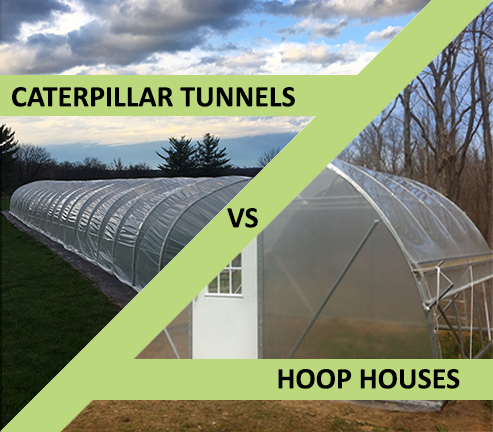
Caterpillar tunnels and hoop houses might look similar from the outside, but very real structural differences exist between the two greenhouse structures, and it is worth noting these differences so that a decision can be made which structure is best for your short and long-term goals.
This post compares caterpillar tunnels and hoop houses. We shed light on what a caterpillar tunnel is, what a hoop house is, and also provide the Pros and Cons of each.
Caterpillar Tunnels: What are they?
In their most basic form, caterpillar tunnels are growing structures that protect crops from the elements with a simple low-cost design.
The low cost design of caterpillar tunnels focuses on providing the fastest possible payback period per initial investment of any growing structure.
In order to achieve the low cost for these structures, caterpillar tunnels typically use more rudimentary anchoring and greenhouse plastic attachment, and they don't include any end-wall framing at all.
While the simple nature of their design has a lot of Pros (which we go over one by one further down in the post), the lack of bracing and hardware components is also the main reason caterpillar tunnel's are often considered "three season structures".
Caterpillar Tunnel Design and Philosophy
The structures are anchored by pounding rebar into the ground, and the bottom of the hoops slide over top of the rebar. Self tapping tek screws are then driven through the hoop itself so that the tip of the screw makes contact with the rebar. This holds the hoop against the rebar anchor.
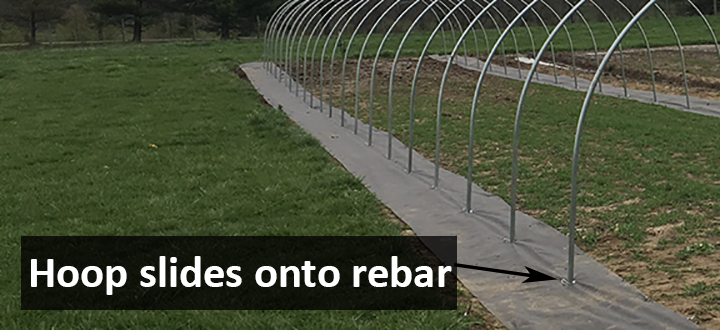
Since Caterpillar Tunnels are more rudimentary structures, they do not include the wind or snow bracing components that would add to the tunnels overall price.
In fact, the only hoop bracing included with a Caterpillar Tunnel is the strapping system that runs the full length of the tunnel at the peak of the structure. This strapping works as the common bracing element often referred to as a purlin.
A purlin is usually a steel tube that runs the full length of a greenhouse, however, in an effort to cut costs for caterpillar tunnels this steel tubing has been replaced with a high strength strap that creates lengthwise tension from end to end.
Caterpillar tunnel costs are kept low by the structures' lack of costly hardware components. For example, most greenhouse plastic is secured to structures using Poly Lock Channel and Spring Wire. While not an expensive component on its own, it would add unwanted costs to a Caterpillar Tunnel since one of the main design philosophies of a Caterpillar Tunnel is its low cost.
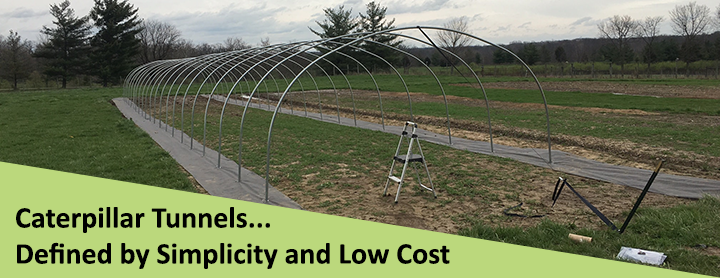
Instead of using Poly Lock Channel and Spring Wire, a Caterpillar Tunnel uses a rope system that keeps the greenhouse plastic in place with a back and forth crisscross rope pattern. This pressure holds the plastic in place while avoiding the need for hardware (which would inflate the price).
Once again, we have to remember that one of the primary purposes of a Caterpillar Tunnel is it's low cost, and in order to achieve this low-cost simplicity must remain one of the central themes of the structures design.
If a simple structure is what you are looking for a Caterpillar Tunnel deserves your consideration. While most caterpillar tunnels are 14 ft. wide, using a 16 ft. wide caterpillar really allows the space-to-cost ratio to be maximized due to the same components being used for a wider structure; this allows for side to side plantings, and there is also a bit more of a straight sidewall when using a 16 ft. wide caterpillar tunnel; this width of caterpillar tunnel can be found here.
Here is a picture of what a 16 ft. wide Caterpillar Tunnel looks like when planted to the brim, and when the end-walls have been completely removed for venting:
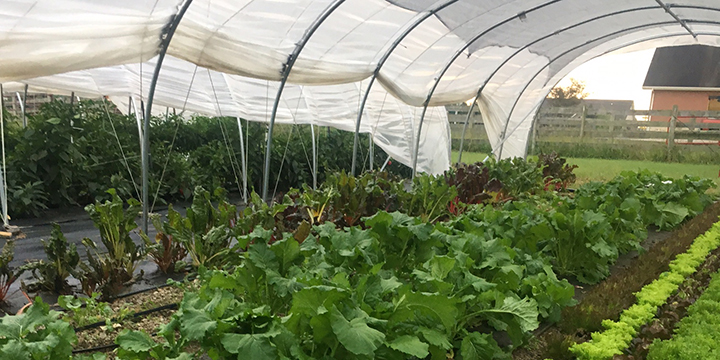
Hoop Houses: What are they?
Hoop houses are growing structures designed for year round crop production through colder months. Like Caterpillar Tunnels, a hoop house is traditionally viewed as one of the lower cost indoor growing structures available to small farmers. However, hoop houses have significantly more structural support, wind bracing, and superior anchoring. In addition to the structural superiority, hoop houses have a more permanent greenhouse plastic attachment method that ensures lack of maintenance. For the reasons above, Hoop Houses are more often considered four season growing structures.
More About Hoop Houses: Tunnel Design and Philosophy
Hoop houses are still considered to be simple "temporary" structures due in part to the fact that they are anchored using methods that don't necessarily require the use of concrete. Most farmers tend to keep hoop house structures covered with plastic through the winter months in order to try and maximize production capacity, and their return on investment for the structure itself. For this reason most hoop houses, in addition to having better anchoring and wind bracing, also come equipped with snow bracing in the form of trusses and trust supports.
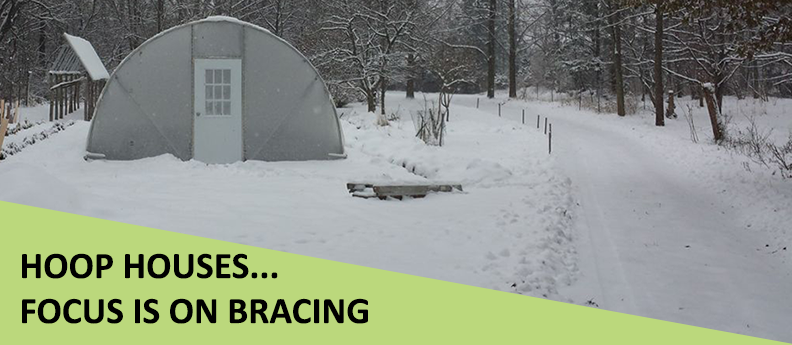
If you read through the section on hoop houses, and are thinking to yourself, "this is the covered growing space I need" then you may want to browse some hoop houses that both affordable and designed with strength in mind. These can be found here.
If you think you need to go through some additional considerations for your hoop house you might want to read our blog post 7 Questions to Ask Before Planning Your Greenhouse Build.
Caterpillar Tunnel or a Hoop House?
This is a difficult question to answer for any grower, and it is specifically difficult for anyone other than yourself to determine since there are a lot of factors to consider. That said, one of the main ways to determine whether your farming operation needs a hoop house or a caterpillar tunnel is by going through the pros and cons of each structure and then determining which of those are most important to your farm operation.
With that in mind, below are some of the main pros and cons of caterpillar tunnels and hoop houses. Hopefully these can help you figure out which structure is best for your farm operation.
Every farm operation is different, and while your farm might put more weight toward a Pro that has to do with speed of installation, another farmer might put more weight in the structure with the best snow bracing. Since only you can decide how to rank the pros and cons it'll be especially important to pay attention to the list we've developed below:
Caterpillar Tunnel Pros and Cons
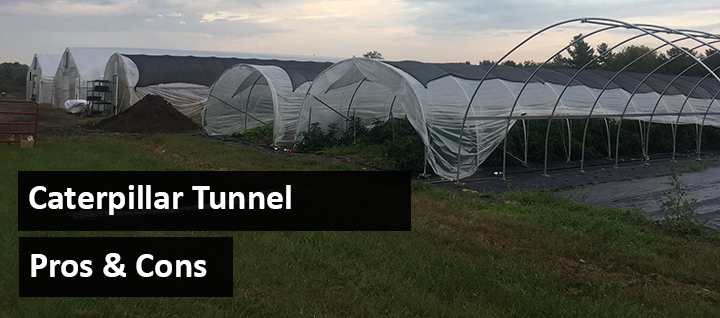
Pros:
- Caterpillar tunnels are inexpensive
- Caterpillar tunnel Assembly doesn't require a lot of building experience to complete
- Caterpillar tunnel assembly can be done very quickly
- Caterpillar tunnels have a fast "pay back period" due to their low baseline cost
- Caterpillar tunnels provide the appropriate amount of weather protection for a large number of crops
- Caterpillar tunnels can easily be deconstructed / dis-assembled, and moved to new locations
Cons
- Caterpillar tunnels are less robust structurally than hoop houses
- Because the structures are more rudimentary they are riskier investments during wind and snow events
- Venting components are built-in to the plastic attachment and are therefore less refined, and because of this there may end up being more time spent adjusting greenhouse plastic in order to vent
- Limited width are possible because of their simple design
Hoop House Pros and Cons
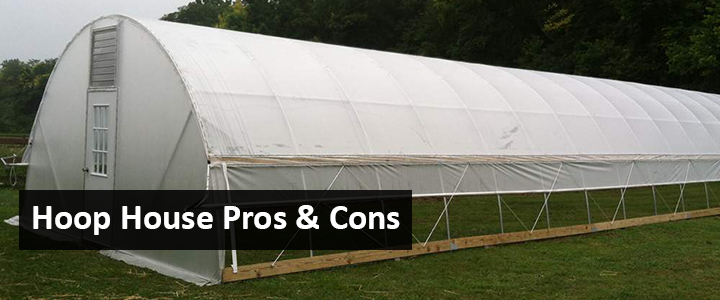
Pros:
- Hoop houses are still relatively inexpensive when compared to more traditional greenhouse structures
- Hoop house assembly is still relatively simple (although there are more features and parts than a caterpillar Tunnel)
- Hoop houses are more robust structurally, and are therefore able to withstand more inclement weather than caterpillar tunnels
- Hoop houses are more ergonomic for interior work; that is to say, you can stand completely and move freely in all parts of a hoop house except for the space very close to the sides
- Ventilation components are more refined, and because of this they should require less of your effort and attention
- Most hoop houses come standard with an entrance door, which makes entering and securing your structure easy
Cons:
- Hoop houses are a bit more difficult to assemble than caterpillar tunnels; they are taller structures with more features and components so there will be more ladder work and assembly steps
- Hoop houses, while still considered inexpensive growing structures, are more costly to construct than caterpillar tunnels
Which Structure is The Correct Choice for My Farm?
This is obviously a choice that needs to be made by you for your specific farm set-up after considering all of the potential pros and cons, as well as what your main purpose would be for a structure on your farm.
Regardless of your farm's budgetary concerns, or intended uses for the structure, both of the structures hold their respective place in the list of helpful farm infrastructure.
Many farm operations have found purpose in both types of structure, and their farms employ the use of the low cost caterpillar tunnels, as well as the more structurally robust hoop house structures.
Building Caterpillar Tunnels and Building Hoop Houses
Both caterpillar tunnels and hoop houses come with a set number of components that make their assembly possible, and if you already have an existing cold frame you want to modify into a caterpillar tunnel or hoop house, there are caterpillar tunnel specific hardware components available here, and hoop house specific building components here.
If you have any questions on Caterpillar Tunnels or Hoop Houses, feel free to call for more info: (833) 886-6351

